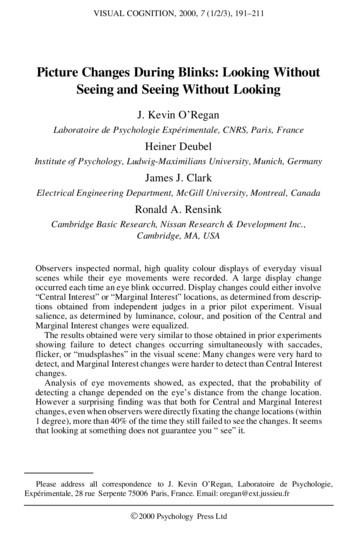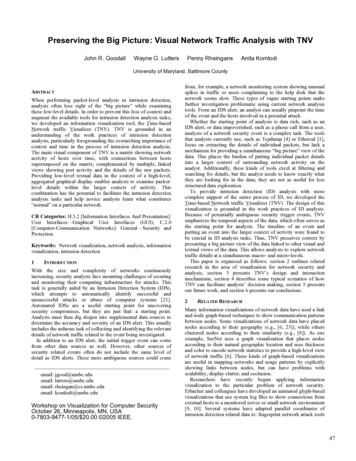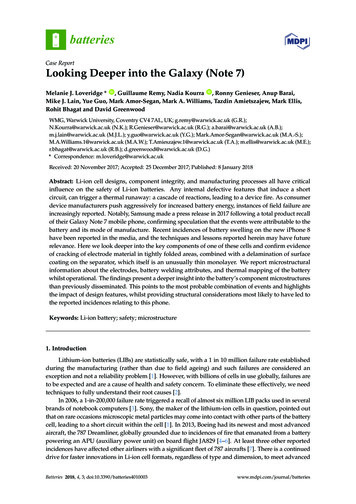
Transcription
VISUAL COGNITION, 2000, 7 (1/2/3), 191–211Picture Changes During Blinks: Looking WithoutSeeing and Seeing Without LookingJ. Kevin O’ReganLaboratoire de Psychologie Expérimentale, CNRS, Paris, FranceHeiner DeubelInstitute of Psychology, Ludwig-Maximilians University, Munich, GermanyJames J. ClarkElectrical Engineering Department, McGill University, Montreal, CanadaRonald A. RensinkCambridge Basic Research, Nissan Research & Development Inc.,Cambridge, MA, USAObservers inspected normal, high quality colour displays of everyday visualscenes while their eye movements were recorded. A large display changeoccurred each time an eye blink occurred. Display changes could either involve“Central Interest” or “Marginal Interest” locations, as determined from descriptions obtained from independent judges in a prior pilot experiment. Visualsalience, as determined by luminance, colour, and position of the Central andMarginal Interest changes were equalized.The results obtained were very similar to those obtained in prior experimentsshowing failure to detect changes occurring simultaneously with saccades,flicker, or “mudsplashes” in the visual scene: Many changes were very hard todetect, and Marginal Interest changes were harder to detect than Central Interestchanges.Analysis of eye movements showed, as expected, that the probability ofdetecting a change depended on the eye’s distance from the change location.However a surprising finding was that both for Central and Marginal Interestchanges, even when observers were directly fixating the change locations (within1 degree), more than 40% of the time they still failed to see the changes. It seemsthat looking at something does not guarantee you “ see” it.Please address all correspondence to J. Kevin O’Regan, Laboratoire de Psychologie,Expérimentale, 28 rue Serpente 75006 Paris, France. Email: oregan@ext.jussieu.frÓ 2000 Psychology Press Ltd
192O’REGAN ET AL.The results are interpreted in terms of the idea that what the observer sees during scene exploration is not determined primarily by the location in the scenebeing fixated by the eyes, but by the scene aspects being attended to. A theory issummarized which applies to the other experiments in the literature on changeblindness, and some new predictions are put forward.INTRODUCTIONRecent studies have shown that surprisingly large changes in a visual scene cango undetected if the changes coincide temporally with the moment an eyesaccade occurs (Grimes, 1996; McConkie, 1991; McConkie & Currie, 1996).The phenomenon seems not to be related to some kind of saccade-specific suppression mechanism, but simply to the visual transient that the saccade produces: Indeed, the effect can also be obtained without saccades if a large visualtransient such as a screen flicker (Rensink, O’Regan, & Clark, 1995, 1997) or afilm cut (in a motion picture sequence, cf. Levin & Simons, 1997) occurssimultaneously with the change, or if the change occurs at the same time assome small local transients, such as mudsplashes on a car windshield, arebriefly spattered over the scene, (O’Regan, Rensink, & Clark, 1996, 1999).If the explanation of the effect truly lies in the distracting influence of thevisual transients that occur simultaneously with the change, then another, ecologically rather important form of transient is likely also to be effective in preventing changes from being detected, namely blinks. Like saccades, blinkscreate a global disruption of the retinal image, and furthermore, at around100–200 msec, their durations are actually several times longer than saccades(20–70 msec). Blinks occur at a relatively high rate (20–30 times per minute,cf. Sun et al., 1997) and so in tasks like driving, which requires continual monitoring of visual conditions, it would be important to know to what extent achange in a traffic light or brake light, or a dangerous road event, may bemissed if it occurs during a blink.It is clear that in any scene there will be aspects that observers will preferentially attend to, and others that they will tend not to attend to. Because thisattentional component of scene recognition would be expected to interactstrongly with the likelihood of detecting a change in the scene, we wished tofind a way of quantifying it. A variety of studies have been done in the attentionand picture memory literature to attempt to understand what causes a pictureaspect to be noticed or remembered, and factors such as visual salience (contrast, size, location, colour, onset characteristics), semantic (coherence, novelty), contextual, and task-related factors, as well as subjects’ individualpreferences, are certainly all involved. For the purposes of our study however,a simple operational measure was required, and we chose to obtain it in thefollowing way.
PICTURE CHANGES DURING BLINKS193We asked a group of five judges to give a short description of each picture.The judges’ descriptions were very coherent, enabling us to define, for eachpicture, several aspects, which we termed “Central Interest” aspects, defined asthose aspects that were mentioned by at least three of the judges. Central Interest aspects tended to concern what one would be tempted to call the main themeof the picture. Similarly, we noted several aspects of each picture, which wetermed “Marginal Interest” aspects, defined as those aspects that were mentioned by none of the judges. In the main experiment, then, by manipulatingwhether changes were caused to occur to Central or Marginal Interest aspects,we had a way of controlling the degree of attention that our subjects would beexpected to pay to the changes.An additional point that will be addressed in this paper concerns the question of eye position: Up until now, little research has been done in natural visualscenes to investigate how close to a display change the eye has to be in order forthe change to be seen (but see Currie, McConkie & Irwin, 1997; Hayhoe,Bensinger, & Ballard, 1998; McConkie & Currie, 1996; Zelinsky, 1997). In thepresent experiment we were able to monitor eye movements while observersinspected the images. We expected that a change would be easier to detect if theeye was looking directly at the change location than if the eye was some waysaway from it. We indeed found that this was the case. However a curious additional fact emerged, namely that directly fixating the change was still no guarantee that the change would be seen. In fact, in more than 40% of the cases, theeye looked directly at the change and yet did not notice it. This phenomenonseemed independent of whether the location was a Central or Marginal Interestlocation. We called it “looking but not seeing” .METHODMaterialsThe experiment involved 48 digitized colour photographs depicting a varietyof natural indoor and outdoor scenes, derived from a commercial picture database (Corel). With each picture was associated a modified picture, in whichsome region had been changed. There were three kinds of changes: Appearance or disappearance of a picture element (this could be an object, part ofobject, surface, or region such as a shadow or the sky); a shift in the position ofan object; a change in the colour of an object, surface or region. The changeswere made by editing the images with image manipulation programs (AdobePhotoshop, Deneba Canvas). Pictures and associated changes were the same asused in our earlier experiments (cf. Rensink et al., 1997, this issue).In half of the pictures the locations of the picture that were changed werechosen to be Central Interest (CI) aspects, and half were chosen to involveMarginal Interest (MI) aspects, defined as explained previously. The change
194O’REGAN ET AL.locations were the same as those used in our earlier experiments. Even thoughMarginal Interest changes tended to involve aspects of the picture that did notconstitute the “main theme” of the picture, we were careful to choose them sothat they physically occupied as much space and were approximately as centrally located in the picture as Central Interest changes. Thus, the mean centroid of the CI locations were at (x,y) pixel coordinates (– 8 136, – 5 86, i.e.0.4 6, 0.2 4 degrees) relative to the centre of the 640 480 pixel screen, andat coordinates (92 195, – 11 139, i.e. 4 8.7, 0.5 6 degrees) for the MIlocations (the values are standard deviations). The nature of the changebetween the original and modified pictures was also carefully controlled so asto ensure that there was as little difference as possible in the visual conspicuityof the change for the CI and MI changes. Thus, the mean proportion of modified pixels in the picture was 4.2 4 % and 5.1 4 %, for CI and MI changesrespectively. The mean Euclidean distance in the RGB values (each coordinatepotentially ranging from 0 to 255) across all the changed pixels was 104 24and 101 51 respectively for CI and MI changes. Finally, the mean intensitychange (potentially ranging from 0, i.e. black to 255, i.e. white) of the changedpixels was 127 63 and 126 110 for CI and MI changes. These values showthat on purely visual measures, the CI and MI changes were very similar. Anydifference in the probability of noticing the changes was therefore probablyattributable to differences in the semantic relevance of the changes.ProcedureBiting the bite plate made with dental compound, the subjects sat with theireyes at a distance of 80 cm from a 100 Hz colour video monitor in a darkenedroom. The area of the screen in which the picture appeared subtended 21 vertically and 28 horizontally at the eye. An SRI dual Purkinje eye tracker registered the subjects’ eye movements and was interfaced to the computer thatcontrolled stimulus presentation.After calibration of the eye tracker using an array of nine dots on the screen,the subjects were shown 10 practice pictures, followed by the 48 test picturesrandomly mixed anew for each subject. A short break was made half waythrough the experiment.Subjects were told that at some moment while they were looking at each picture, the picture would change, and that their task was to press a button immediately this occurred. While the button was maintained pressed, the computerdisplayed a 20 20 pixel (0.8 0.8 ) white outline square on the screen whichmoved over the picture and continuously indicated where the eye was looking.As this was occurring, subjects were asked to look at the location where theyhad seen the change, thereby indicating its location with the eye-contingentmoving square, and release the button. After this the screen went dark and a
PICTURE CHANGES DURING BLINKS195fixation cross appeared in the screen’s middle. The subject looked at the fixation cross, and pressed the button again, causing the next picture to appear.Picture changes occurred every time the subject blinked: The original picture was replaced by the changed picture, or vice versa. If after 48 seconds or15 blinks the change had not yet been detected by the subject, the computerwaited for a random time between 0.5 and 1 sec, and displayed the changewithout waiting for a blink. This ensured that subjects would always ultimatelysee the change.The subjects were not told that their blinks caused the display changes, norwere they told how many times a change would occur. Since they were activelysearching for changes, some subjects adopted the strategy of staring at thescreen intently, which unfortunately had the consequence of preventing blinks.Such subjects were told that the eye tracker worked better when the eye wasmoist and that they should therefore blink every now and then. After the experiment the experimenter interviewed the subjects to determine whether they haddetected a correlation with blinks. Of the 10 subjects, 2 said they had noticedsome kind of correlation.Eye movements were sampled continuously at 400 Hz during the trials.Blinks were detected by monitoring an output channel of the SRI tracker whichindicates the presence of a “valid” pupil in the infrared image. The displaychange was made by switching video display buffers, and could thus beeffected during the retrace period between two successive video frames.Because display changes occurred entirely within the blink period, generallyno visual transient at all was visible to subjects and the image appeared perfectly steady. Exceptions to this were cases when the subjects blinked withoutcompletely closing their eyes, or when reflections, eyelashes, or other artefactscaused the computer to register a blink when in fact none had occurred (seelater).SubjectsTen paid naïve subjects, students at the Ludwig Maximilians Universität, participated in the experiment.RESULTSData AnalysisDetection of blinks by the pupil signal of the SRI tracker is not completely reliable. The eyelid may only partially close, or reflections or eyelashes may partially interfere with the image. Whereas during the experiment the displaychanges were triggered by the pupil-disappearance signal, after the experimentit was possible to additionally examine the eye-movement record in relation to
196O’REGAN ET AL.the pupil signal. A normal blink can be recognized because it is accompaniedby a distinctive “signature” in the output of the eye tracker, involving a typicalrapid vertical movement and return of the eye (cf. Collewijn, van der Steen, &Steinman, 1985). By carefully examining the eye traces by hand we eliminatedrecords where we thought the change had been incorrectly triggered by someartefact. This data selection was done by the experimenters, but blind to thenature and outcome of each trial.A further question in the data analysis concerns what we mean by the location of the eye at the moment of the blink. Analysis of the records showed thatin the majority of cases, the eye blink occurred at the beginning of a fixationand ended before the end of the fixation. In some cases, however, the blinkstraddled an eye movement. However, in these cases the eye v
Seeing and Seeing Without Looking J. Kevin O’Regan Laboratoire de Psychologie Expérimentale, CNRS, Paris, France Heiner Deubel Institute of Psychology, Ludwig-Maximilians University, Munich, Germany James J. Clark Electrical Engineering Department, McGill University, Montreal, Canada Ronald A. Rensink Cambridge Basic Research, Nissan Research & Development Inc., Cambridge, MA, USA .










